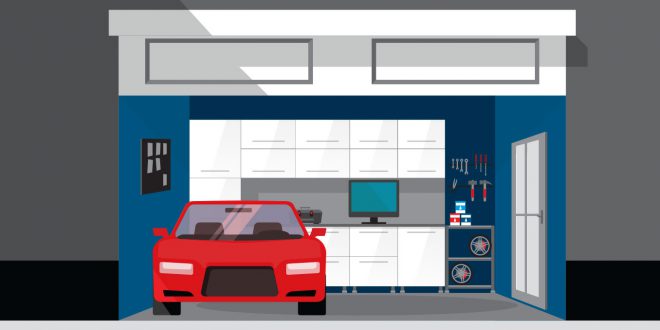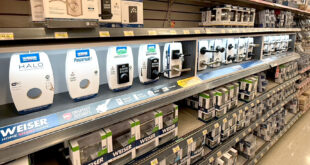
Click the picture to download a PDF of this story.
By Chad Husted, chusted@nrha.org
Garages were added to homes in the 1920s and 1930s as vehicle ownership became more common. In the early years, the sole purpose of a garage was to house vehicles, work on repair projects and keep equipment protected from the elements. As garages became more important to the daily life of the family, homebuyers began seeking attached garages that were more fully integrated into the design of the house.
Many modern homeowners continue to use their garages for those traditional purposes.
Yet the creativity of homeowners and organizational professionals has led to more projects in the space.
For many homeowners, the garage has become the main portal to enter the home, rather than a front door from the porch. In addition, the areas of the home a garage entrance may lead to will vary depending on a home’s layout, from laundry and mud rooms to more lived-in spaces like living rooms or kitchens. This variation of entrance options from the garage may also affect the ways in which the garage is used.
“The garage in the modern home is indicative of how homeowners see themselves,” says Paul Greskovich, owner of Garage Craft Interiors in Holmdel, New Jersey. “It’s what they see when they leave in the morning, and it’s the first thing they see when they arrive home.”
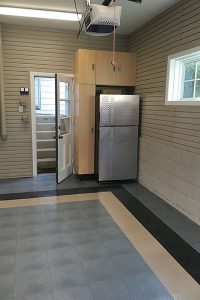 Given the increased importance of the garage, homeowners are taking a more evaluative approach to how the space is used. Home improvement retailers should keep in mind the many uses for garages, such as storage space for vehicles and large lawn-care items or dedicated showcases for prized cars and other toys.
Given the increased importance of the garage, homeowners are taking a more evaluative approach to how the space is used. Home improvement retailers should keep in mind the many uses for garages, such as storage space for vehicles and large lawn-care items or dedicated showcases for prized cars and other toys.
To evaluate how homeowners are choosing to rework their garage spaces, Hardware Retailing spoke with Greskovich, a renovation professional who specializes in organizing and rehabbing garages and other areas of the home.
Whether designing for function or style, consumers are taking on garage projects with a passion. Retailers who are ready to harness that enthusiasm have an opportunity to assist customers with DIY-level garage projects.
A Place for (Almost) Everything
When it comes to spacious garages, the options for storage are almost unlimited. This strongpoint for garages is also, somewhat predictably, a problem for many people.
As the garage can be seen as an open space with room for large vehicles, outdoor equipment like power tools, lawnmowers and other home improvement tools, it can transform into a cluttered catch-all. Lack of organization and inefficient use of space in the garage can contribute to buildup that frustrates homeowners who want to utilize the space creatively.
The area around the door into the home can become its own space with storage options necessary for one function, while another corner can be dedicated to something else, such as space for a hobby.
For Greskovich, every garage renovation has to start with a thorough decluttering of the space. The act of purging unused or underused items can even be cathartic. A retailer’s knowledge and supplies can help in that aspect.
“Retailers can talk to their customers about how to best store the items they’ve decided to keep after cleaning out a garage,” Greskovich says. “They can also be a resource for supplies involved in the cleaning project, because most garage projects are going to require items like degreasers, gloves and brooms to fully complete.”
Garage Craft Interiors concentrates on top-of-the-line remodels in the New Jersey area, especially residential neighborhoods catering to high-income households outside New York City. While his business serves a market that isn’t often interested in DIY projects, Greskovich says all garages have potential, no matter the scale.
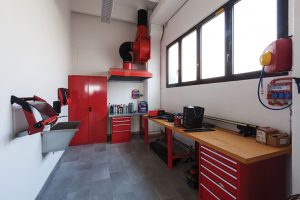 In some cases, the scale is over the top and includes extensive renovations. Vehicle enthusiasts may choose to install car lifts or create showrooms for their vehicles. These types of projects may be outside the scope of average homeowners’ skills, while other projects, such as overhead storage, can be limited by the age and physical capabilities of the homeowner.
In some cases, the scale is over the top and includes extensive renovations. Vehicle enthusiasts may choose to install car lifts or create showrooms for their vehicles. These types of projects may be outside the scope of average homeowners’ skills, while other projects, such as overhead storage, can be limited by the age and physical capabilities of the homeowner.
These projects may be beyond the skill level of a DIYer, but they represent just a portion of the kinds of projects homeowners are undertaking. Not everyone wants or needs a parking space fit for a king, but they could be looking to find tidy storage options or items needed to renovate a portion of the garage for another purpose.
Given the garage’s position as a common entryway of many homes, homeowners are eager to keep messy items outside the home until they can be washed. In this pursuit, the conventional mudroom is being moved into the garage, complete with large multipurpose sinks and storage options for clothing and equipment, such as sports uniforms and hunting gear.
“Many homeowners want to compartmentalize the space of their garage. It doesn’t have to be one large room with cars and tools,” Greskovich says. “The area around the door into the home can become its own space with storage options necessary for one function, while another corner can be dedicated to something else, such as space for a hobby.”
One of those options includes creating a workout center in the garage, which can be a good solution for homes that don’t have a spare room or basement to store bulky workout equipment.
Greskovich says the diverse options available from retailers can be an asset for these kinds of projects. Home improvement centers won’t necessarily sell items such as free weights, but they do have the necessary products to turn what is normally a bare, poorly lit garage area into a more comfortable space.
Flooring materials, like molded interlocking foam pads that cushion concrete floors is a common need, Greskovich says. Other opportunities to greatly improve garage aesthetics that remain firmly in DIY territory include lighting and wiring to create a more lived-in look. Air conditioning and heating equipment are also needed to make a garage more comfortable.
“Lighting is something many hardware retailers have invested in, and it’s one of the simplest ways to improve the garage space,” Greskovich says. Surface-mounted LED lighting options along with more electrical outlets and wiring for comfort items like TVs and cable connections are all ways to improve the space.
Homeowners also want their garages to have more aesthetic appeal, which is another area where retailers can help. The expertise and product assortment that retailers offer can be a strong counterpart for DIYers or consumers who work with consultants to make their garages an extension of their living space. Renovations also offer opportunities for retailers to partner with other businesses in the garage innovation market to bring the best of both operations to these projects.
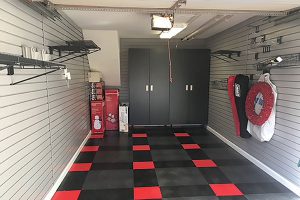 Storage That Grows With You
Storage That Grows With You
Many homeowners want to transform a section of their garage or go for full makeovers to create a more livable space, but others simply want a better way to tame an area of the home that is underutilized for its storage capabilities.
Retailers can offer solutions such as pegboard storage, custom cabinets, shelving and workbench setups. Hanging repurposed kitchen cabinets is also a common project.
Retailers who already focus on special orders should be able to thrive on these types of products. Merchandising a few examples to draw in customers looking at garage projects can open the door to the custom options that are available.
Garage projects, like other home improvement projects that might stretch an owner’s skillset, also present opportunities for retailers who include installed sales in their portfolio. The projects needed to install storage in the garage are closely related to common installed sales projects throughout the rest of the home.
An item ubiquitous in home storage solutions in the garage are slat wall products that work with tongue and groove mounts to provide storage options for bikes, cabinets and tools.
Wall-mounted storage systems also offer scalability. One panel might work for new homeowners, but a growing family can steadily expand to need more panels and accessories.
“The same items you’ll be storing when the kids are 11 and 12 aren’t what you’ll be wanting to store when they’re in high school,” Greskovich says.
The issue of scalability also extends to ceiling storage options. Going vertical with storage can be as heavy duty as installing a pulley system to raise and lower a shelf to a DIY setup of beams placed above the rails for the garage door.
 Dangers of DIY
Dangers of DIY
Greskovich cautioned retailers to get as much information about a customer’s intended project and to be ready to offer advice should a project be beyond the customer’s comfort zone or skill.
Retailers are often on the lookout for a customer who might be in over their head on a project, but the garage has its own obstacles that consumers might not see coming.
A common project Greskovich has seen DIYers miss the mark on in garage renovations is epoxy flooring. With its professional feel and high-gloss sheen, many homeowners looking to enhance the style in their garages have attempted adding a floor coating. It doesn’t always end the way they hope.
“Floor coatings are all about preparation, and if you don’t have experience in that prep, you won’t get the end result you want,” Greskovich says.
Garage floors will often have imperfections and stains that must all be removed prior to application of the coating. If the preparation is done improperly, coatings can peel and look messy.
Greskovich recommends mats and other nonbinding flooring alternatives for inexperienced DIYers, adding another option for retailers to offer their customers the best solution for their skill level and ambition.
Home improvement retailers already have many of the products and knowledge needed to assist homeowners in both project goals. With a bit more focused knowledge and the right mix of products on display, hardware stores can be a go-to option for the professional garage renovator or DIYer looking to add some wow to a garage.
“Retailers can be a great asset for storage options with their customers, and garages just need a bit more specialized knowledge,” Greskovich says. “It’s all about value analysis, both with what a customer wants to keep in the garage and what kind of solutions they want to install. Retailers can help customers do it right and be a lot happier with an important part of the home.”
 Hardware Retailing The Industry's Source for Insights and Information
Hardware Retailing The Industry's Source for Insights and Information

